A Simple Method to Validate Power Loss in Medium Voltage SiC MOSFETs and Schottky Diodes Operating in a Three-Phase Inverter
Abstract
1. Introduction
2. Power Module with SiC MOSFETs and Schottky Diodes in a Three-Phase Inverter
2.1. Switching Losses
2.2. On-State Performance
- Area I when only the transistor is conducting (excluding dead-time periods), duration (π + 2σ);
- Area II when the transistor and diode share a negative current (π − 2σ).
2.3. Power Loss and Junction Temperatures Estimations
3. Power Losses Validation in a Half-Bridge Circuit
3.1. Square Wave Controlled Half-Bridge Circuit
3.2. Method of the Inverter Power Loss Emulation
- Electro-thermal calculations for the selected operating point of a three-phase inverter according to the method presented in Figure 2, using Equations (1)–(8) to find power losses in transistor PT an diode PD.
- Calculations for the half-bridge circuit to find recommended circuit parameters of the half-bridge circuit that enables the same amount of PT and PD. Possibly, the same temperatures may also be planned.
- Apply the set of parameters to the test setup with the tested module and perform tests until the system reaches steady state.
- Measure power losses and (if possible) junction temperatures.
- Verify the results.
4. Experimental Verification of the Half-Bridge Circuit with 3.3 kV/450 A SiC MOSFET Modules
5. Experimental Validation of Power Loss in Three-Phase Inverter Using the Half-Bridge Circuit
6. Conclusions
Author Contributions
Funding
Conflicts of Interest
Appendix A
References
- DiMarino, C.; Boroyevich, D.; Burgos, R.; Johnson, M.; Lu, G.Q. Design and development of a high-density, high-speed 10 kV SiC MOSFET module. In Proceedings of the 2017 19th European Conference on Power Electronics and Applications (EPE’17 ECCE Europe), Warsaw, Poland, 11–14 September 2017; pp. 1–10. [Google Scholar]
- Zhang, L.; Ji, S.; Gu, S.; Huang, X.; Palmer, J.; Giewont, W.; Tolbert, L.M. Design Considerations of High-Voltage-Insulated Gate Drive Power Supply for 10 kV SiC MOSFET in Medium-Voltage Application. In Proceedings of the 2019 IEEE Applied Power Electronics Conference and Exposition (APEC), Anaheim, CA, USA, 17–21 March 2019; pp. 425–430. [Google Scholar]
- Parashar, S.; Kumar, A.; Bhattacharya, S. High Power Medium Voltage Converters Enabled by High Voltage SiC Power Devices. In Proceedings of the 2018 International Power Electronics Conference (IPEC-Niigata 2018—ECCE Asia), Niigata, Japan, 4–8 April 2018; pp. 3993–4000. [Google Scholar]
- Marzoughi, A.; Wang, J.; Burgos, R.; Boroyevich, D. Characterization and Evaluation of the State-of-the-Art 3.3-kV 400-A SiC MOSFETs. IEEE Trans. Ind. Electron. 2017, 64, 8247–8257. [Google Scholar] [CrossRef]
- Gill, L.; Ikari, T.; Kai, T.; Li, B.; Ngo, K.; Dong, D. Medium Voltage Dual Active Bridge Using 3.3 kV SiC MOSFETs for EV Charging Application. In Proceedings of the 2019 IEEE Energy Conversion Congress and Exposition (ECCE), Baltimore, MD, USA, 29 September–3 October 2019; pp. 1237–1244. [Google Scholar]
- Ionita, C.; Nawaz, M.; Ilves, K.; Iannuzzo, F. Comparative assessment of 3.3kV/400A SiC MOSFET and Si IGBT power modules. In Proceedings of the 2017 IEEE Energy Conversion Congress and Exposition (ECCE), Cincinnati, OH, USA, 1–5 October 2017; pp. 1343–1349. [Google Scholar]
- Ozpineci, B.; Tolbert, L.M.; Islam, S.K.; Hasanuzzaman, M. Effects of silicon carbide (SiC) power devices on HEV PWM inverter losses. IECON’01. In Proceedings of the 27th Annual Conference of the IEEE Industrial Electronics Society (Cat. No.37243), Denver, CO, USA, 29 November–2 December 2001; Volume 2, pp. 1061–1066. [Google Scholar]
- Fonteneau, X.; Morel, F.; Buttay, C.; Morel, H.; Lahaye, P. Predicting static losses in an inverter-leg built with SiC normally-off JFETs and SiC diodes. In Proceedings of the Twenty-Eighth Annual IEEE Applied Power Electronics Conference and Exposition (APEC), Long Beach, CA, USA, 17–21 March 2013; pp. 2636–2642. [Google Scholar]
- Jordan, J.; Esteve, V.; Sanchis-Kilders, E.; Dede, E.J.; Maset, E.; Ejea, J.B.; Ferreres, A. A comparative performance study of a 1200 V Si and SiC MOSFET intrinsic diode on an induction heating inverter. IEEE Trans. Power Electron. 2014, 29, 2550–2562. [Google Scholar] [CrossRef]
- Rąbkowski, J.; Płatek, T. Comparison of the power losses in 1700V Si IGBT and SiC MOSFET modules including reverse conduction. In Proceedings of the European Conference on Power Electronics and Applications, EPE 2015, Geneva, Switzerland, 8–10 September 2015; pp. 1–10. [Google Scholar]
- Yin, S.; Tseng, K.; Tong, C.; Simanjorang, R.; Gajanayake, C.; Gupta, A.K. A 99% efficiency SiC three-phase inverter using synchronous rectification. In Proceedings of the 2016 IEEE Applied Power Electronics Conference and Exposition (APEC), Long Beach, CA, 20–24 March 2016; pp. 2942–2949. [Google Scholar]
- Yin, S.; Liu, Y.; Liu, Y.; Tseng, K.J.; Pou, J.; Simanjorang, R. Comparison of SiC Voltage Source Inverters Using Synchronous Rectification and Freewheeling Diode. IEEE Trans. Ind. Electron. 2018, 65, 1051–1061. [Google Scholar] [CrossRef]
- Nayak, P.; Hatua, K. Parasitic Inductance and Capacitance-Assisted Active Gate Driving Technique to Minimize Switching Loss of SiC MOSFET. IEEE Trans. Ind. Electron. 2017, 64, 8288–8298. [Google Scholar] [CrossRef]
- Xiao, C.; Chen, G.; Odendaal, W.G. Overview of power loss measurement techniques in power electronics systems. IEEE Trans. Ind. Appl. 2007, 43, 657–664. [Google Scholar] [CrossRef]
- Fuchs, F.W.; Schroder, J.; Wittig, B. State of the technology of power loss determination in power converters. In Proceedings of the 2013 15th European Conference on Power Electronics and Applications (EPE), Lille, France, 2–6 September 2013; pp. 1–10. [Google Scholar]
- Aarniovuori, L.; Musikka, T.; Kosonen, A.; Niemelä, M.; Pyrhönen, J. Three alternative methods to determine voltage source converter losses. In Proceedings of the 2015 17th European Conference on Power Electronics and Applications (EPE’15 ECCE-Europe), Geneva, Switzerland, 8–10 September 2015; pp. 1–10. [Google Scholar]
- Christen, D.; Badstuebner, U.; Biela, J.; Kolar, J.W. Calorimetric power loss measurement for highly efficient converters. In Proceedings of the 2010 International Power Electronics Conference—ECCE Asia—IPEC, Sapporo, Japan, 21–26 June 2010; pp. 1438–1445. [Google Scholar]
- Bolte, S.; Wohlrab, L.; Afridi, J.K.; Fröhleke, N.; Böcker, J. Calorimetric measurement of wide-bandgap semiconductors switching losses. In Proceedings of the PCIM Europe 2017—International Exhibition and Conference for Power Electronics Intelligent Motion Renewable Energy and Energy Management, Nuremberg, Germany, 16–18 May 2017; pp. 1–6. [Google Scholar]
- Rothmund, D.; Bortis, D.; Kolar, J.W. Accurate Transient Calorimetric Measurement of Soft-Switching Losses of 10-kV SiC mosfets and Diodes. IEEE Trans. Power Electron. 2018, 33, 5240–5250. [Google Scholar] [CrossRef]
- Anurag, A.; Acharya, S.; Prabowo, Y.; Gohil, G.; Kassa, H.; Bhattacharya, S. An accurate calorimetric method for measurement of switching losses in silicon carbide (SiC) MOSFETs. In Proceedings of the 2018 IEEE Applied Power Electronics Conference and Exposition (APEC), San Antonio, TX, USA, 4–8 March 2018; pp. 1695–1700. [Google Scholar]
- Zhang, Z.; Guo, B.; Wang, F.F.; Jones, E.A.; Tolbert, L.M.; Blalock, B.J. Methodology for Wide Band-Gap Device Dynamic Characterization. IEEE Trans. Power Electron. 2017, 32, 9307–9318. [Google Scholar] [CrossRef]
- Ghosh, A.; Ho, C.N.M.; Prendergast, J. A Cost-effective Compact Automatic Testing System for Dynamic Characterization of Power Semiconductor Devices. In Proceedings of the 2019 IEEE Energy Conversion Congress and Exposition (ECCE), Baltimore, MD, USA, 29 September–3 October 2019; pp. 2026–2032. [Google Scholar]
- Oyarbide, E.; Bernal, C.; Molina-Gaudó, P. New Current Measurement Procedure Using a Conventional Rogowski Transducer for the Analysis of Switching Transients in Transistors. IEEE Trans. Power Electron. 2017, 32, 2490–2492. [Google Scholar] [CrossRef]
- Forest, F.; Huselstein, J.J.; Faucher, S.; Elghazouani, M.; Ladoux, P.; Meynard, T.A.; Turpin, C. Use of opposition method in the test of high-power electronic converters. IEEE Trans. Ind. Electron. 2006, 53, 530–541. [Google Scholar] [CrossRef]
- Brandelero, J.; Cougo, B.; Meynard, T.; Videau, N. A non-intrusive method for measuring switching losses of GaN power transistors. In Proceedings of the IECON 2013—39th Annual Conference of the IEEE Industrial Electronics Society, Vienna, Austria, 10–13 November 2013; pp. 246–251. [Google Scholar]
- Wechsler, M.; Simon, M.; Edler, S.; Pforr, J. A simple technique to measure the semiconductor switching and conduction losses of inverters at specified chip temperatures. In Proceedings of the 2015 IEEE Energy Conversion Congress and Exposition (ECCE), Montreal, QC, Canada, 20–24 September 2015; pp. 6594–6601. [Google Scholar]
- Kadavelugu, A.; Suryanarayana, H.; Liu, L.; Pan, Z.; Belcastro, C.; Paatero, E. A simple and accurate efficiency measurement method for power converters. In Proceedings of the 2017 IEEE Applied Power Electronics Conference and Exposition (APEC), Tampa, FL, USA, 26–30 March 2017; pp. 3265–3270. [Google Scholar]
- Lu, J.L.; Qiu, Y.; Chen, D. A full power emulation platform for evaluating power semiconductors. In Proceedings of the 2018 IEEE Applied Power Electronics Conference and Exposition (APEC), Anaheim, CA, USA, 17–21 March 2018; pp. 2861–2867. [Google Scholar]
- Stella, F.; Pellegrino, G.; Armando, E.; Daprà, D. Advanced testing of SiC power MOSFET modules for electric motor drives. In Proceedings of the 2017 IEEE International Electric Machines and Drives Conference (IEMDC), Miami, FL, USA, 21–24 May 2017; pp. 1–8. [Google Scholar]
- Biswas, S.; Reusch, D.; de Rooij, M.; Neville, T. Evaluation of measurement techniques for high-speed GaN transistors. In Proceedings of the 2017 IEEE 5th Workshop on Wide Bandgap Power Devices and Applications (WiPDA), Santa Ana Pueblo, NM, USA, 30 October–1 November 2017; pp. 105–110. [Google Scholar]
- Keuck, L.; Jabbar, N.; Schafmeister, F.; Böcker, J. Switching Loss Characterization of Wide Band-Gap Devices by an Indirect Identification Methodology. In Proceedings of the 2018 20th European Conference on Power Electronics and Applications (EPE’18 ECCE Europe), Riga, Latvia, 17–21 September 2018. [Google Scholar]
- Costa, P.B.; Silva, J.F.; Pinto, S.F. Experimental evaluation of SiC MOSFET and GaN HEMT losses in inverter operation. In Proceedings of the IECON 2019-45th Annual Conference of the IEEE Industrial Electronics Society, Lisbon, Portugal, 14–17 October 2019; Volume 1, pp. 6595–6600. [Google Scholar]
- Ishigaki, T.; Hayakawa, S.; Murata, T.; Nozoe, T.; Onose, H.; Miki, H.; Takayanagi, Y. 3.3 kV/450 A Full-SiC nHPD2 (next High Power Density Dual) with Smooth Switching. In Proceedings of the PCIM Europe 2017; International Exhibition and Conference for Power Electronics, Intelligent Motion, Renewable Energy and Energy Management, Nuremberg, Germany, 16–18 May 2017; pp. 1–6. [Google Scholar]
- Hayes, J.; Curbow, W.A.; Sparkman, B.; Martin, D.; Olejniczak, K.; Wijenayake, A.; McNutt, T. Dynamic Characterization of Next Generation Medium Voltage (3.3 kV, 10 kV) Silicon Carbide Power Modules. In Proceedings of the PCIM Europe 2017; International Exhibition and Conference for Power Electronics, Intelligent Motion, Renewable Energy and Energy Management, Nuremberg, Germany, 16–18 May 2017; pp. 1–7. [Google Scholar]
- Negishi, T.; Tsuda, R.; Ota, K.; Iura, S.; Yamaguchi, H. 3.3 kV All-SiC Power Module for Traction System Use. In Proceedings of the PCIM Europe 2017; International Exhibition and Conference for Power Electronics, Intelligent Motion, Renewable Energy and Energy Management, Nuremberg, Germany, 16–18 May 2017; pp. 1–6. [Google Scholar]
- Bierrhoff, M.H.; Fuchs, F.W. Semiconductor Losses in Voltage and Current Source IGBT Converters Based on Analytical Derivation. In Proceedings of the 2004 IEEE 35th Annual Power Electronics Specialists Conference, Aachen, Germany, 20–25 June 2004; pp. 2836–2842. [Google Scholar]
- Rabkowski, J.; Płatek, T. A study on power losses of the 50 kVA SiC converter including reverse conduction phenomenon. Bull. Pol. Acad. Sci. Tech. Sci. 2016, 64, 1–8. [Google Scholar] [CrossRef][Green Version]
- Rabkowski, J.; Sobieski, R.; Zdanowski, M.; Piasecki, S. 3.3 kV/450 a SiC MOSFET Module—Modelling and Experiments. In Proceedings of the 20th European Conference on Power Electronics and Applications, Riga, Latvia, 17–21 September 2018; pp. 1–10. [Google Scholar]
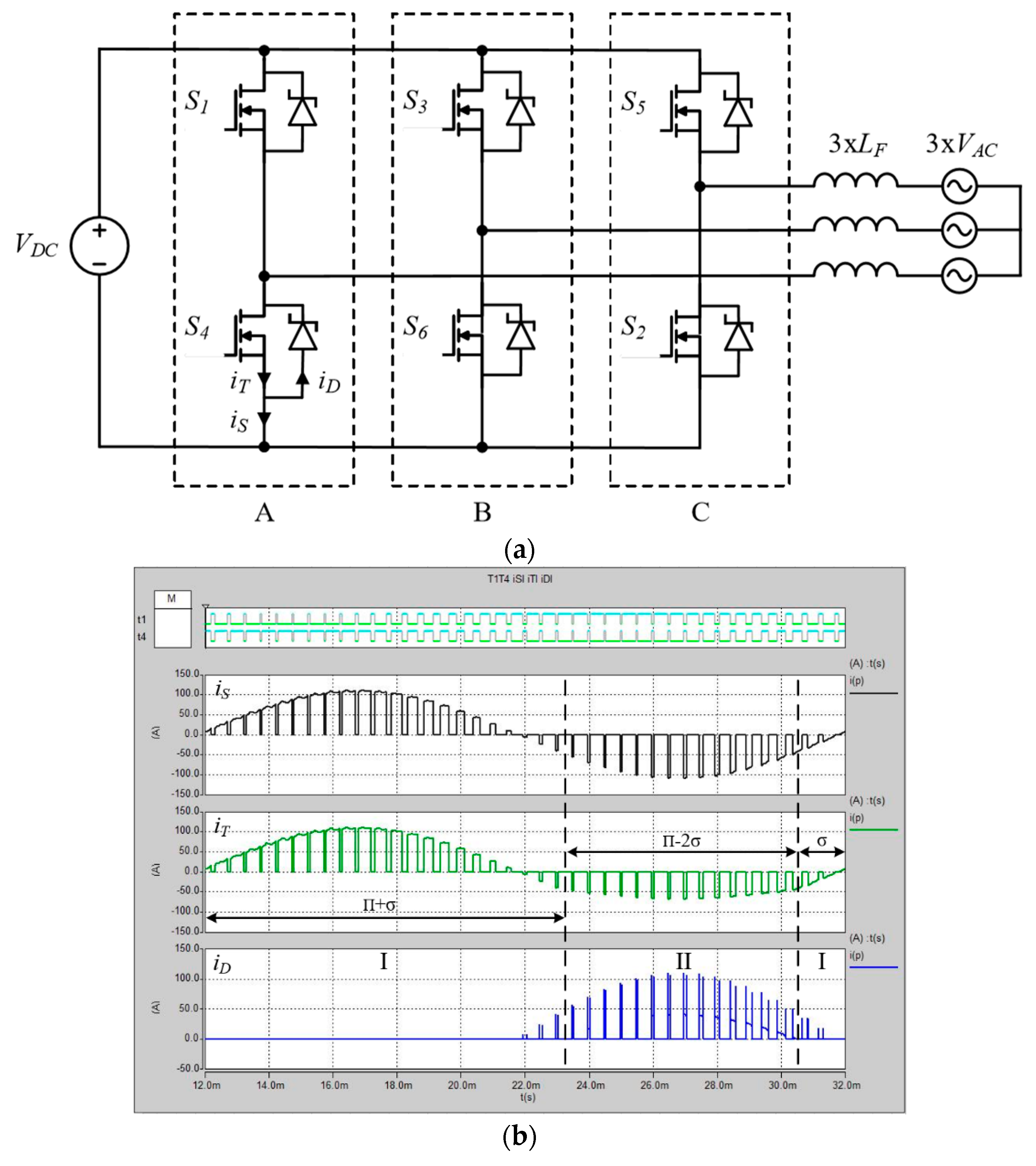
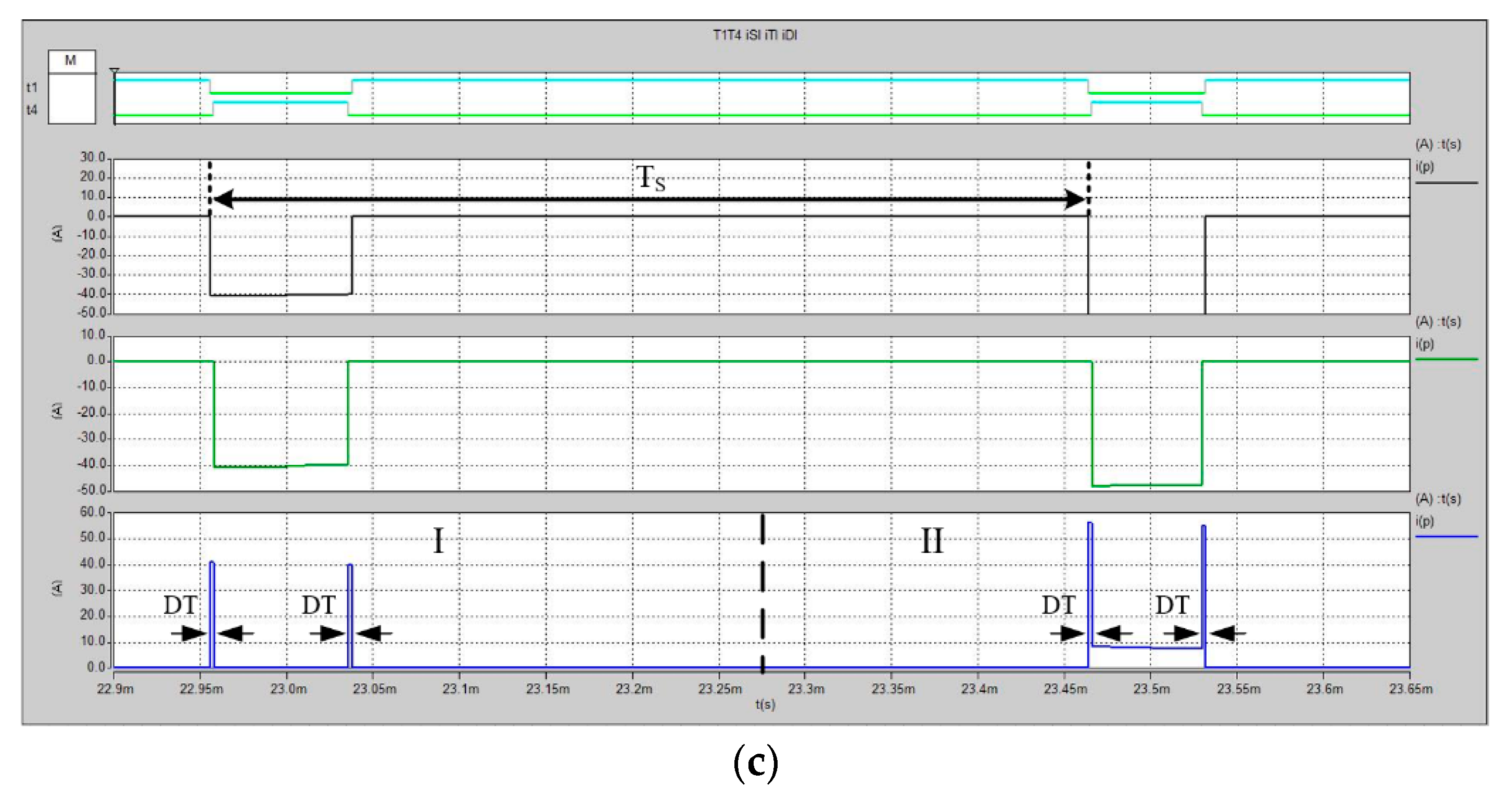
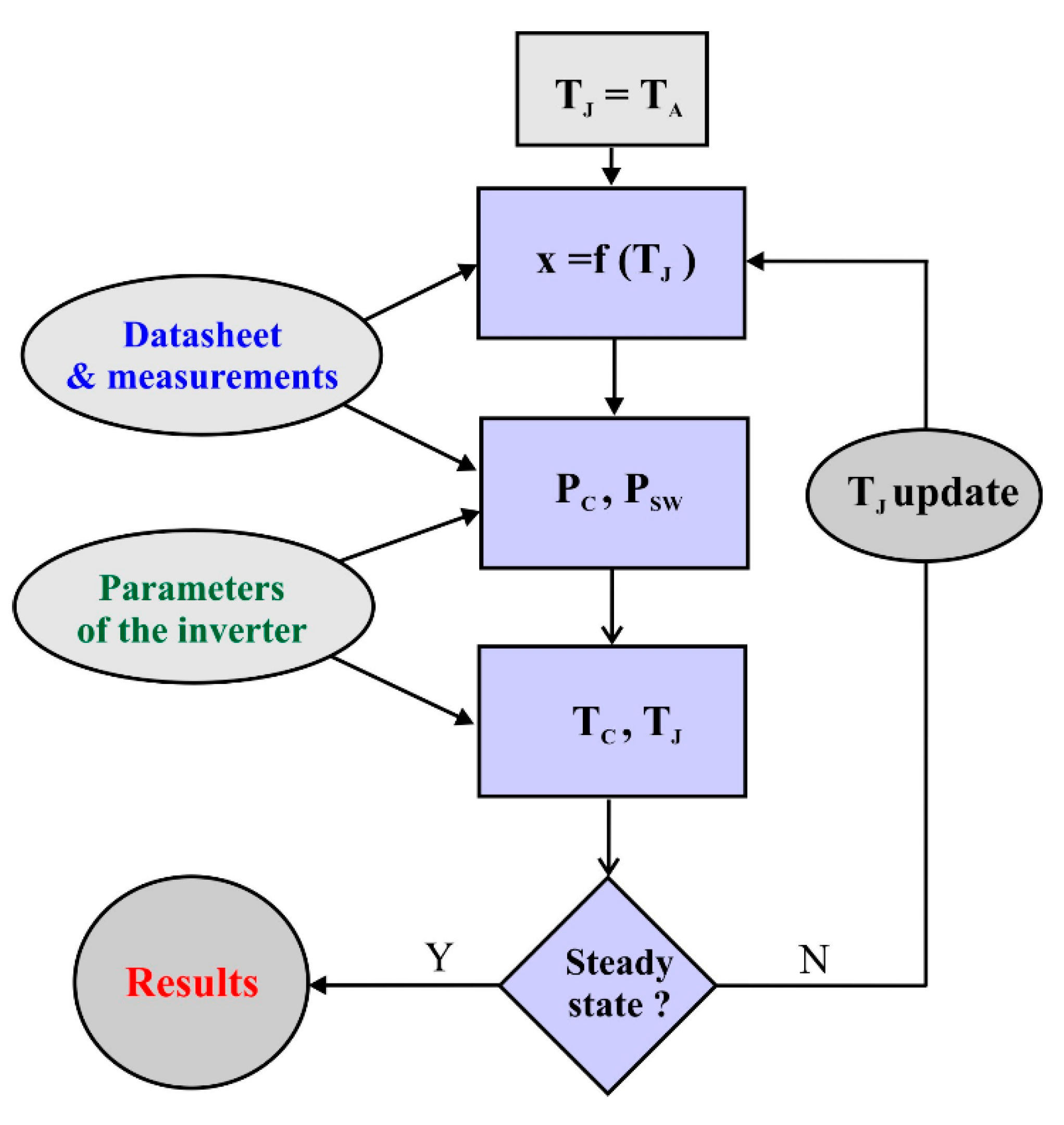
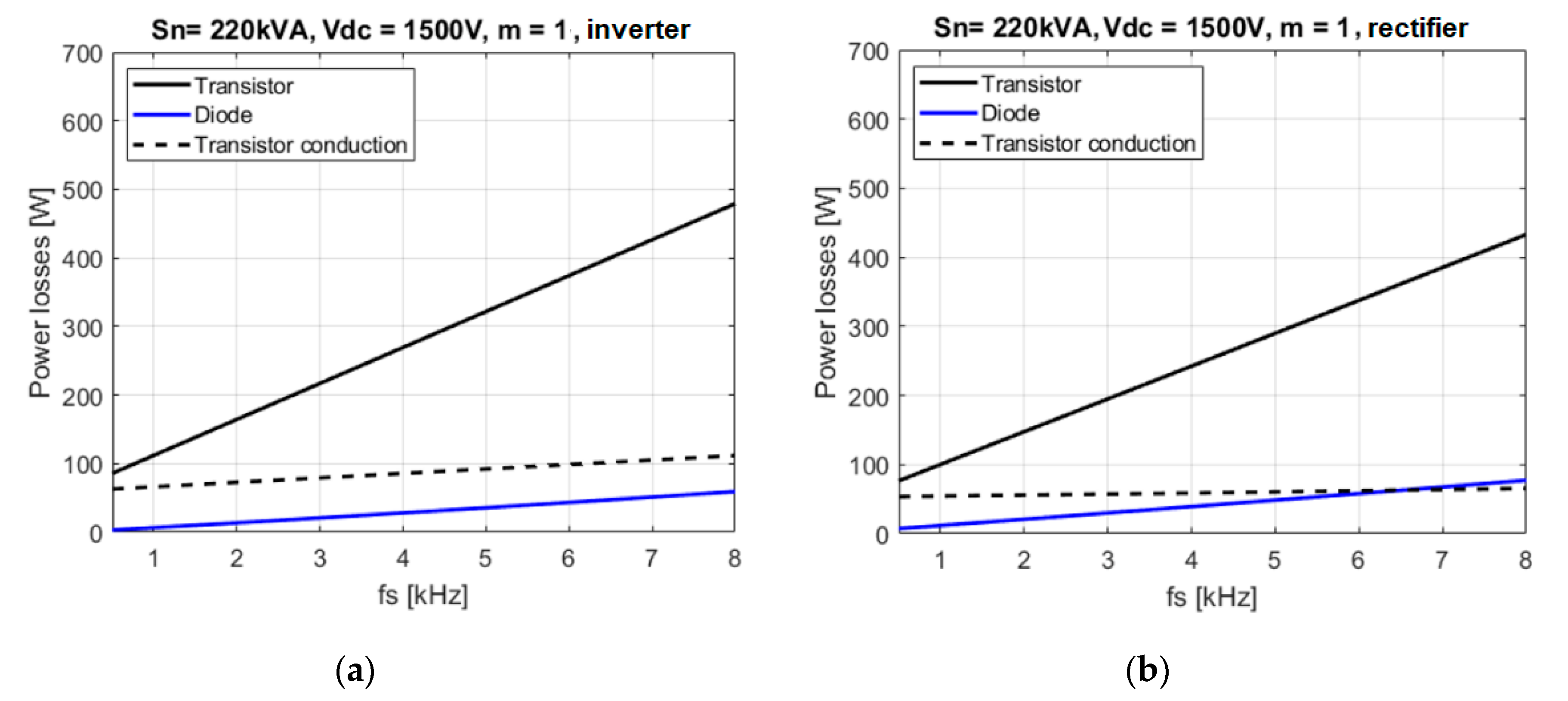


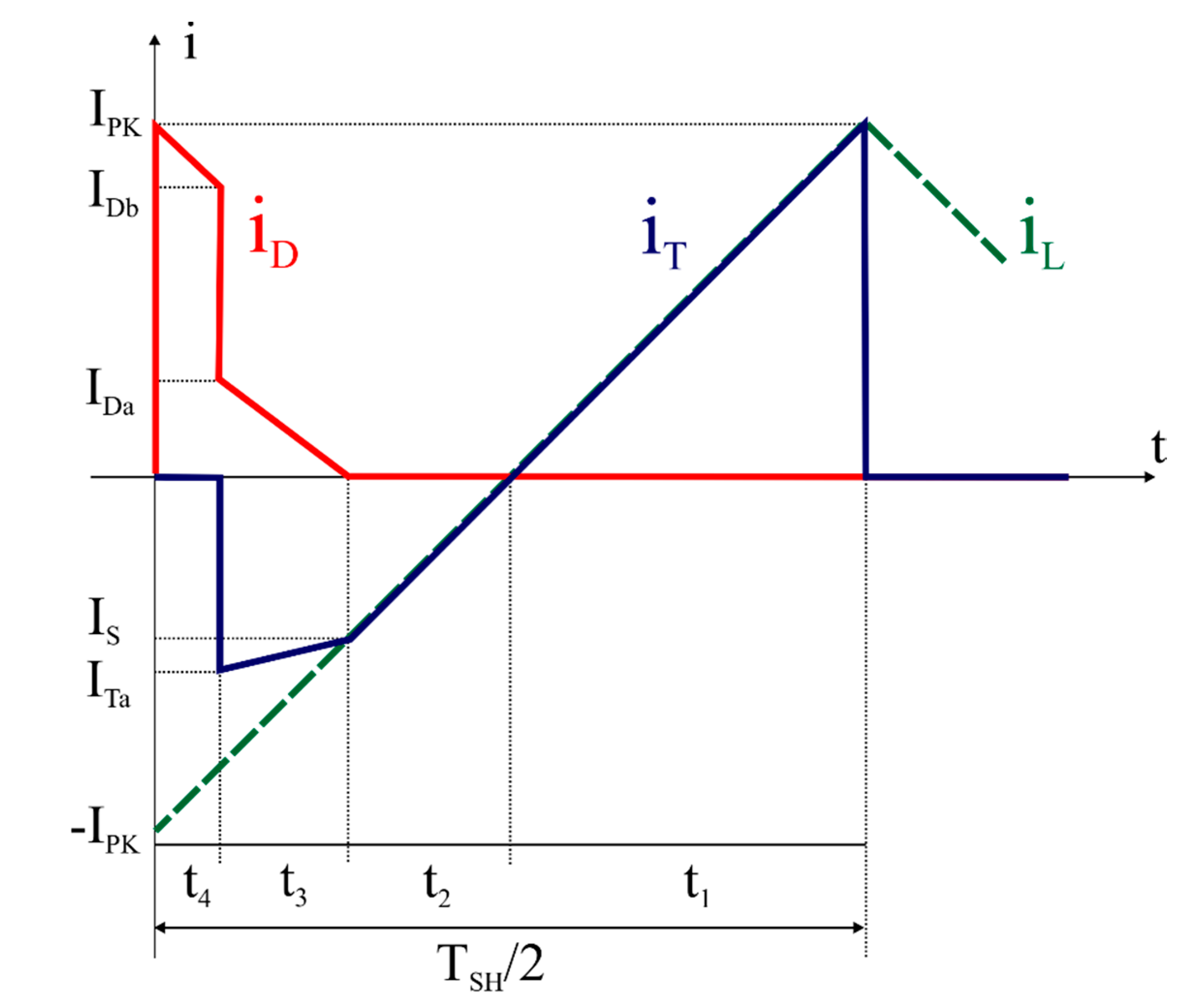
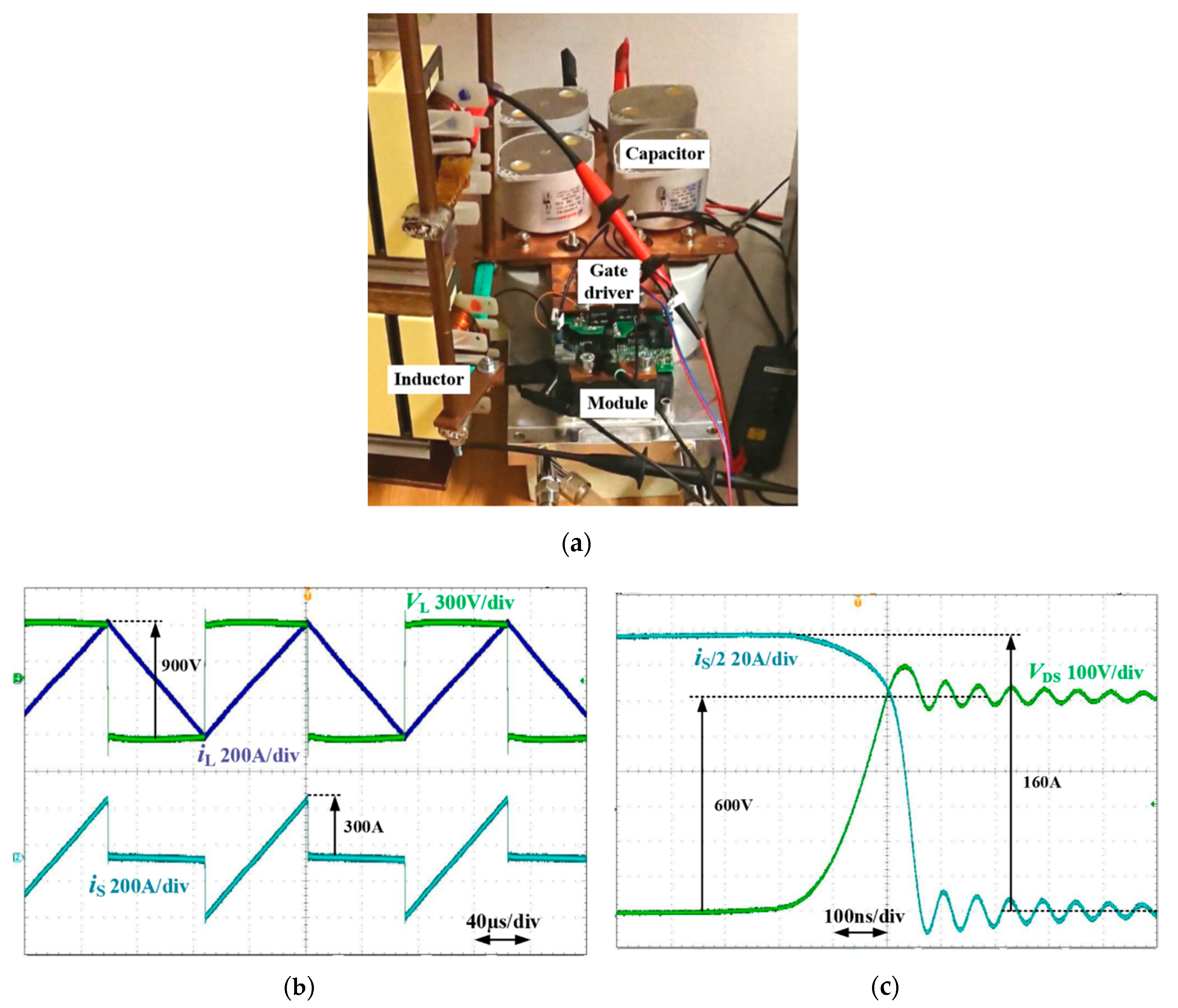

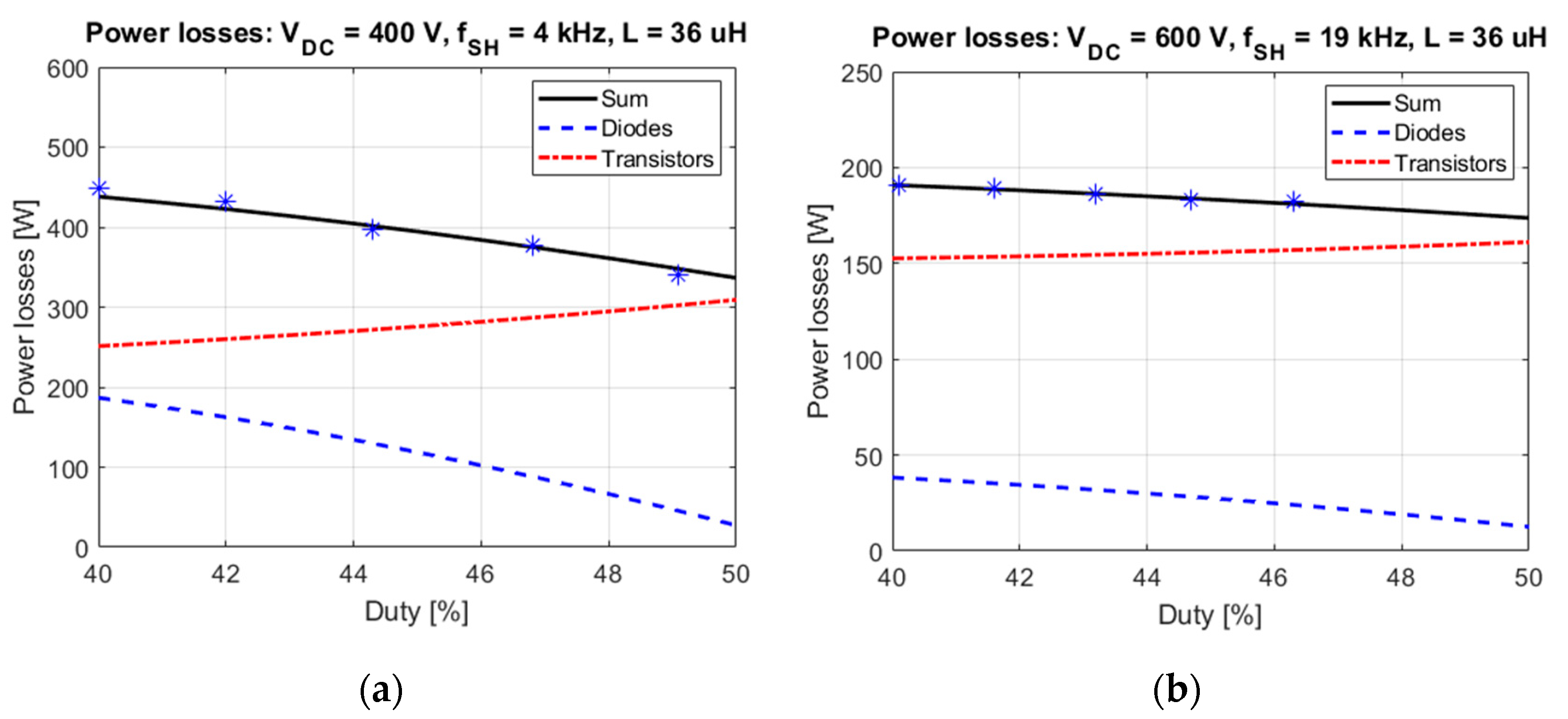
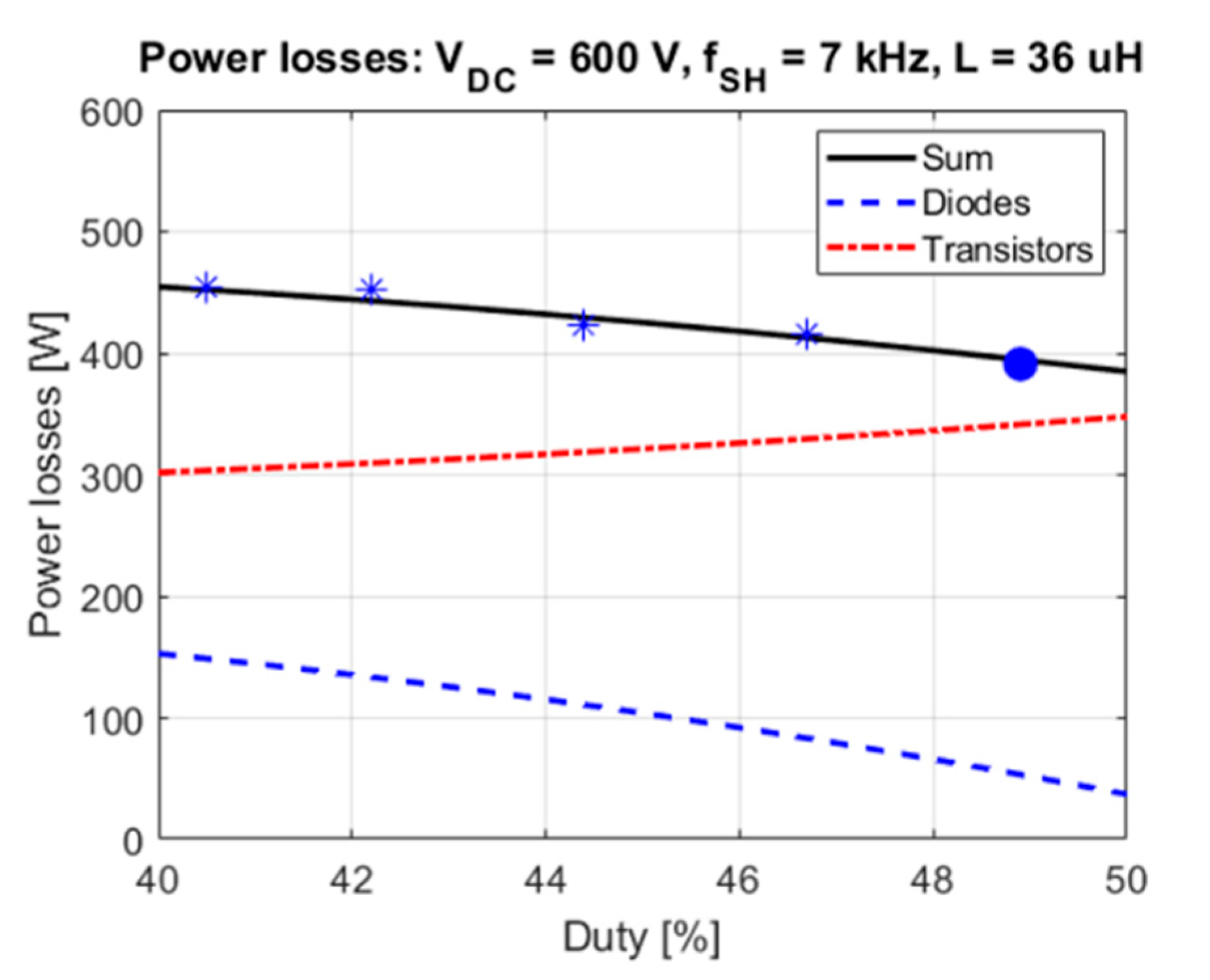
| Operating Point | Power Comparison | ||||||
|---|---|---|---|---|---|---|---|
| VDC (V) | L (µH) | fSH (kHz) | IPK (A) | ||||
| 400 | 36 | 4 | 348 | 49.1–40 | 348–438 | 340–448 | 2.3 |
| 400 | 36 | 7 | 192 | 48.9–40.5 | 154–181 | 154–187 | 3.3 |
| 500 | 36 | 10 | 171 | 48–41.6 | 184–202 | 186–210 | 4 |
| 500 | 56 | 10 | 114 | 48–41.6 | 106–117 | 102–117 | 3.8 |
| 600 | 36 | 7 | 296 | 48.9–40.5 | 390–449 | 391–454 | 2.7 |
| 600 | 36 | 13 | 159 | 48–41.7 | 227–243 | 222–245 | 2.2 |
| 600 | 36 | 19 | 104 | 46.3–40.1 | 181–191 | 182–191 | 0.6 |
© 2020 by the authors. Licensee MDPI, Basel, Switzerland. This article is an open access article distributed under the terms and conditions of the Creative Commons Attribution (CC BY) license (http://creativecommons.org/licenses/by/4.0/).
Share and Cite
Rąbkowski, J.; Skoneczny, H.; Kopacz, R.; Trochimiuk, P.; Wrona, G. A Simple Method to Validate Power Loss in Medium Voltage SiC MOSFETs and Schottky Diodes Operating in a Three-Phase Inverter. Energies 2020, 13, 4773. https://doi.org/10.3390/en13184773
Rąbkowski J, Skoneczny H, Kopacz R, Trochimiuk P, Wrona G. A Simple Method to Validate Power Loss in Medium Voltage SiC MOSFETs and Schottky Diodes Operating in a Three-Phase Inverter. Energies. 2020; 13(18):4773. https://doi.org/10.3390/en13184773
Chicago/Turabian StyleRąbkowski, Jacek, Hubert Skoneczny, Rafał Kopacz, Przemysław Trochimiuk, and Grzegorz Wrona. 2020. "A Simple Method to Validate Power Loss in Medium Voltage SiC MOSFETs and Schottky Diodes Operating in a Three-Phase Inverter" Energies 13, no. 18: 4773. https://doi.org/10.3390/en13184773
APA StyleRąbkowski, J., Skoneczny, H., Kopacz, R., Trochimiuk, P., & Wrona, G. (2020). A Simple Method to Validate Power Loss in Medium Voltage SiC MOSFETs and Schottky Diodes Operating in a Three-Phase Inverter. Energies, 13(18), 4773. https://doi.org/10.3390/en13184773





